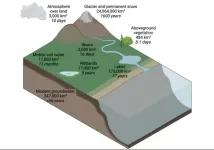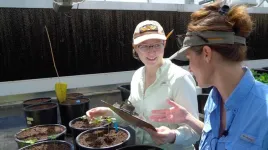New study from Chapman University reveals rapid return of water from ground to atmosphere through plants
Research reshapes understanding of terrestrial water cycle, implications for climate and ecosystem health
2025-01-09
(Press-News.org) Orange, California - January 9, 2025: A new study led by scientists in the Schmid College of Science and Technology at Chapman University provides the first comprehensive global estimates of the amount of water stored in Earth’s plants and the amount of time it takes for that water to flow through them. The information is a missing piece of the puzzle in understanding the global water cycle and how that cycle is being altered by changes in land use and climate.
The study, published today, January 9, in the journal Nature Water, finds that Earth’s vegetation stores about 786 km3 of water, only about 0.002% of the total amount of freshwater stored on Earth. The study also finds that the time it takes for water to flow through plants (referred to as transit or turnover time) and return to the atmosphere is among the fastest in the global water cycle, ranging from just five days in croplands to 18 days in evergreen needleleaf forests. The transit of water through plants is particularly fast in croplands, grasslands and savannas. The results underscore vegetation's dynamic role in the water cycle. In comparison to the global annual median of 8.1 days for water to transit through plants from entry to exit, the water in lakes is estimated to take 17 years, and the water in glaciers is estimated to take 1600 years.
“We have known for a long time that most of the water that returns from the ground to the atmosphere does so through plants, but until now, we did not really know how long it took for that water to transit through plants. Our results show that the transit of water through plants occurs on the order of days, rather than months, years, or centuries, as it does in other parts of the water cycle,” said the study’s lead author Dr. Andrew Felton, who carried out the work as part of a U.S. Department of Agriculture Fellowship while at Chapman University and is now a professor at Montana State University.
The research team notes that by combining estimates of the transit of water through plants with the transit of water through the atmosphere (about 8-10 days) and the transit time of water through soil before being taken up by plants (about 60 to 90 days), they can begin to estimate the complete amount of time it takes for a drop of water to move through the terrestrial water cycle.
“Plants are the forgotten part of the global water cycle,” said Felton. “In many cases, plants are not even represented on water cycle diagrams, which is ironic because we already know they play this critical role in returning water from the ground to the atmosphere.”
To generate the estimates, the research team first calculated the amount of water stored in plants using data from NASA’s Soil Moisture Active Passive Mission (SMAP) satellite mission, which provided high-resolution estimates of the water in soils. The SMAP mission originally saw plants as interfering with the soil moisture measurements, and was correcting for their presence. The Chapman researchers found those corrections actually held valuable information for understanding the water cycle. The team combined estimates of plant water storage with cutting-edge estimates of the rates at which water is leaving plants to determine the transit time of water through vegetation. The result was five years of monthly water storage and transit time estimates at a spatial resolution of 9 km2.
The research team also found that the transit time of water through vegetation varied considerably across different land cover types, climate and seasons. The transit time of water through croplands was significantly and consistently the fastest, with water transiting through plants in less than a day during the peak of the growing season.
“One important observation is that croplands around the world tend to have very similar and very fast transit times,” said Dr. Gregory Goldsmith, senior author and an associate professor of Biological Sciences at Chapman University. “This indicates that land use change may be homogenizing the global water cycle and contributing to its intensification by more rapidly recycling water back to the atmosphere where it can turn into heavy rain events.”
“The results suggest that the transit time of water through plants is likely to be very sensitive to events such as deforestation, drought and wildfire, which will fundamentally change the time it takes for water to flow through the water cycle,” Felton said.
###
About Chapman University
Founded in 1861, Chapman University is a nationally ranked private university in Orange, California, about 30 miles south of Los Angeles. Chapman serves nearly 10,000 undergraduate and graduate students, with a 12:1 student-to-faculty ratio. Students can choose from 123 areas of study within 11 colleges for a personalized education. Chapman is categorized by the Carnegie Classification as an R2 "high research activity" institution. Students at Chapman learn directly from distinguished world-class faculty including Nobel Prize winners, MacArthur fellows, published authors and Academy Award winners. The campus has produced a Rhodes Scholar, been named a top producer of Fulbright Scholars and hosts a chapter of Phi Beta Kappa, the nation's oldest and most prestigious honor society. Chapman also includes the Harry and Diane Rinker Health Science Campus in Irvine. The university features the No. 4 film school and No. 66 business school in the U.S. Learn more about Chapman University: www.chapman.edu.
Media Contact:
Carly Murphy, Public Relations Coordinator | carmurphy@chapman.edu | Desk: 714-289-3196 | Mobile: 714-497-9683
DOI
10.1038/s44221-024-00365-9
Article Title
Global estimates of the storage and transit time of water through vegetation
Article Publication Date
Jan 9, 2025
END
[Attachments] See images for this press release:

ELSE PRESS RELEASES FROM THIS DATE:
2025-01-09
On December 24th, AES Andes, a subsidiary of the US power company AES Corporation, submitted a project for a massive industrial complex for environmental impact assessment. This complex threatens the pristine skies above ESO’s Paranal Observatory in Chile’s Atacama Desert, the darkest and clearest of any astronomical observatory in the world [1]. The industrial megaproject is planned to be located just 5 to 11 kilometres from telescopes at Paranal, which would cause irreparable damage to astronomical observations, in particular due to light pollution emitted throughout the project’s operational life. Relocating the complex would save one ...
2025-01-09
Irvine, Calif., Jan. 9, 2025 — An international research team led by the University of California, Irvine has discovered a new type of skeletal tissue that offers great potential for advancing regenerative medicine and tissue engineering.
Most cartilage relies on an external extracellular matrix for strength, but “lipocartilage,” which is found in the ears, nose and throat of mammals, is uniquely packed with fat-filled cells called “lipochondrocytes” that provide super-stable internal support, enabling ...
2025-01-09
Manufacturers increasingly but still infrequently follow Food and Drug Administration guidance that recommends testing pulse oximeters on participants with a range of skin pigmentations, according to a new study led by researchers at the Johns Hopkins Bloomberg School of Public Health.
The FDA made the recommendation in 2013, following reports that pulse oximeters—devices that measure blood-oxygen levels by shining light through the skin—can be less accurate when used on people with dark skin and that undetected low oxygen levels are more common ...
2025-01-09
MINNEAPOLIS – Press registration is now open for journalists who wish to attend the 77th Annual Meeting of the American Academy of Neurology (AAN). The 2025 AAN Annual Meeting will be held from April 5-9 in San Diego and online.
The AAN Annual Meeting brings together thousands of neurologists and neuroscience professionals, offering the latest in scientific discoveries and advances in neurological research. There will be over 3,200 abstracts covering 25 neurology topics and specialties. The meeting will include late-breaking research, key lectures and more than ...
2025-01-09
Anita Say Chan, an associate professor in the School of Information Sciences at the University of Illinois Urbana-Champaign, has authored a new book that identifies how the eugenics movement foreshadows the predatory data tactics used in today's tech industry. Her book, Predatory Data: Eugenics in Big Tech and Our Fight for an Independent Future, was released this month by the University of California Press.
Over a century ago, the eugenics movement sought to eliminate "undesirable" traits in society through selective breeding (sterilization). It was biased against marginalized groups ...
2025-01-09
EL PASO, Texas (Jan. 9, 2025) – If building strength and muscle mass is part of your New Year’s Resolution, you may want to add a new routine to your workout.
Neuromuscular electrical stimulation (NMES), or electrical muscle stimulation for short, uses electrical currents to contract muscles. The stimulation devices are easy to use and widely available on the market, according to Sudip Bajpeyi, Ph.D., a professor in the Department of Kinesiology at The University of Texas at El Paso, but he has often wondered, “Can these stimulators offer ...
2025-01-09
The University of Tennessee Institute of Agriculture (UTIA) has received a $210,000 grant from USDA’s National Institute of Food and Agriculture (NIFA) to support ongoing integrated pest management (IPM) programs across Tennessee.
An environmentally sensitive approach to pest management that emphasizes affordability and long-term sustainability, IPM practices have been implemented statewide courtesy of UT Extension specialists in fields such as agronomy, weed management, entomology, plant pathology, soil health and pesticide education. The recently ...
2025-01-09
Key takeaways
Both intuition and past research suggest that whether people deem someone trustworthy depends on that person’s past behavior and reputation for betrayal.
In a series of experiments, psychologists found that subjects regarded those who previously exhibited that behavior as less trustworthy. However, when the betrayal benefited them or had no effect on them, participants regarded the betrayer as trustworthy.
This pattern was largely consistent across the types of relationships studied: friendships, romantic relationships and professional relationships.
Imagine this scenario: Two people cheat on their partners with each other ...
2025-01-09
UNIVERSITY PARK, Pa. — Antibiotic-resistant Salmonella is a serious public health concern that has increased in recent years as the bacteria have developed ways to survive drugs. According to the U.S. Centers for Disease Control and Prevention, people can get Salmonella from eating contaminated food products or from infected people or animals — typically via unintentional contact with feces via touching hands or stroking a pet. However, a team of Penn State researchers have found that household dogs are an overlooked transmission point for zoonotic pathogens such as nontyphoidal Salmonella, which can cause diarrhea, fever and abdominal cramps, with some ...
2025-01-09
For decades, catalysts have been unsung heroes in daily life. These workhorses transform a starting material into a product or fuel with lower energy, like the yeast in bread making and human-made catalysts for converting raw materials into fuels more efficiently and sustainably. A promising class of these helpful substances, called single atom catalysts, has emerged, and researchers need new methods to better understand them. More specifically, they want to know how the structure of the sites where chemical reactions occur, called active sites, affects the catalyst’s ability to speed up the chemical reaction rate, known as the activity.
In an important step forward, researchers ...
LAST 30 PRESS RELEASES:
[Press-News.org] New study from Chapman University reveals rapid return of water from ground to atmosphere through plants
Research reshapes understanding of terrestrial water cycle, implications for climate and ecosystem health





